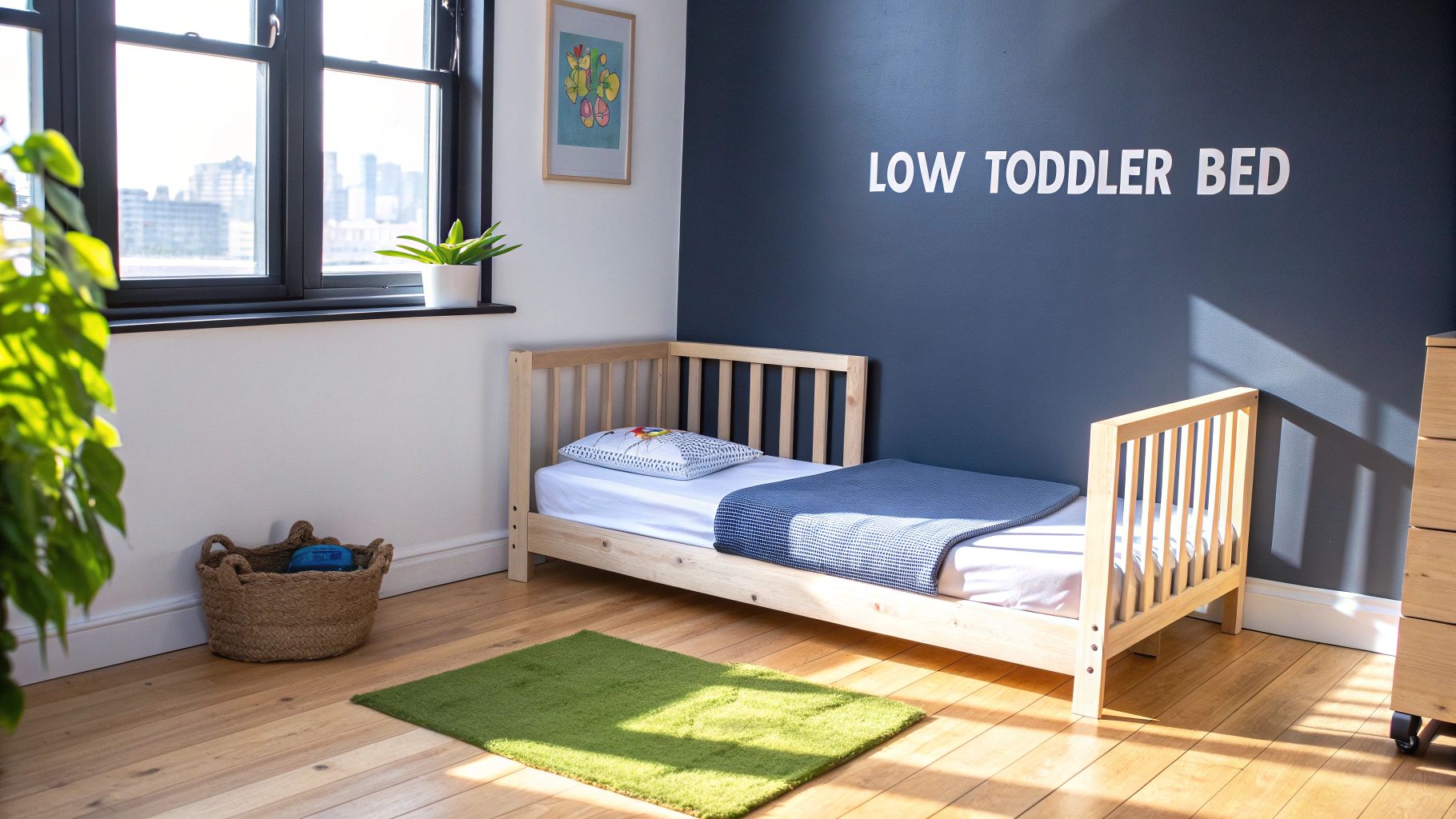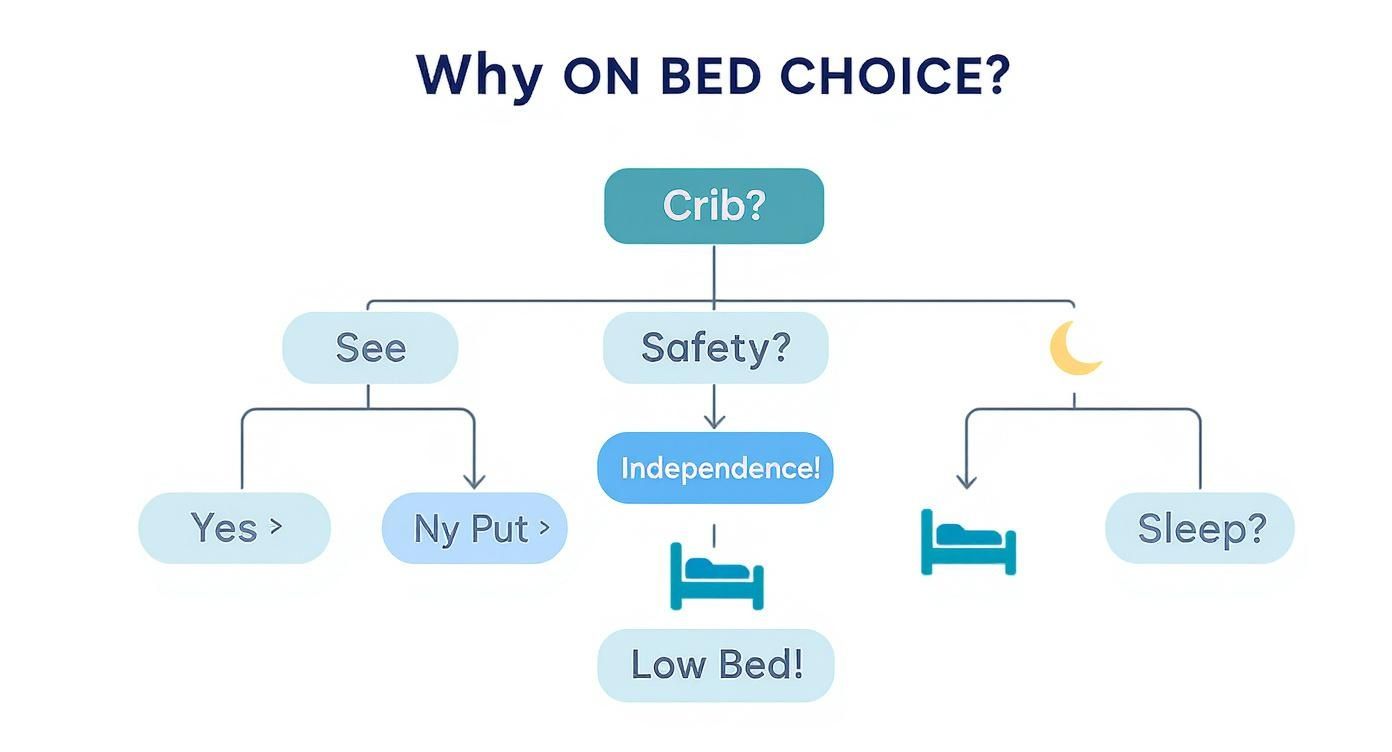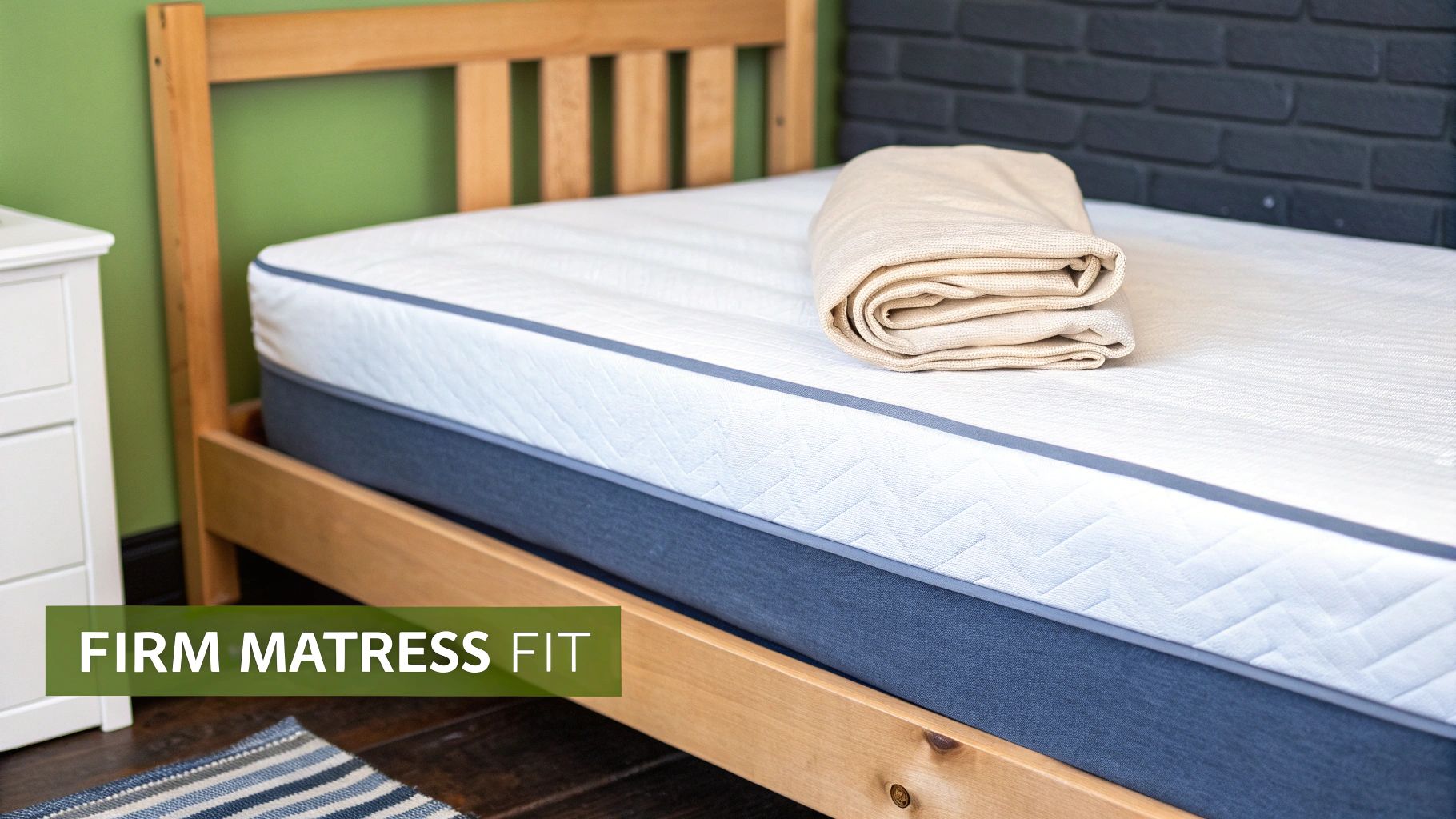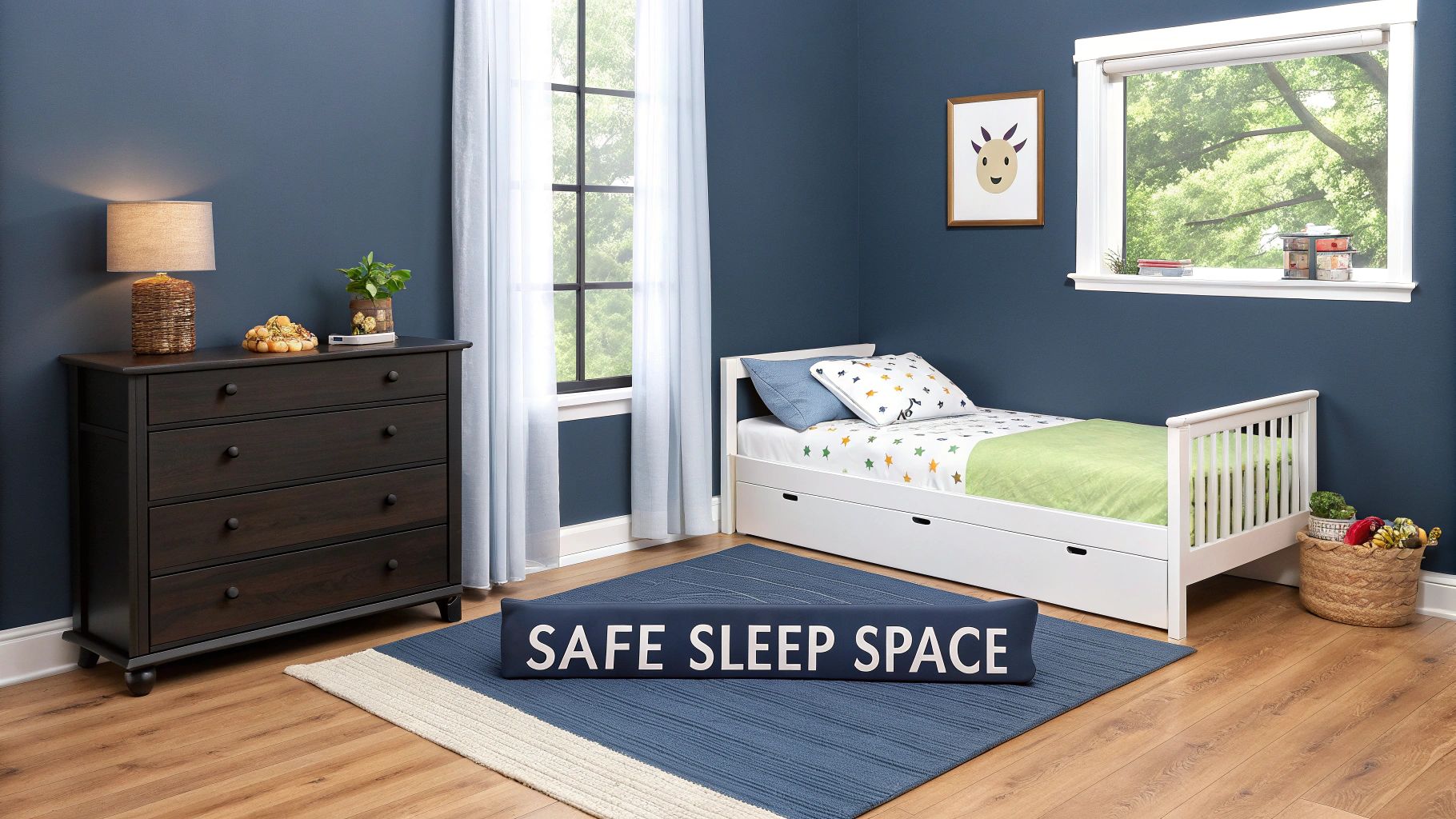
A Parent’s Guide to Low Toddler Beds
Share
So, what exactly is a low toddler bed? You've probably heard it called a floor bed, and the concept is beautifully simple: it’s a bed frame designed so the mattress sits just inches off the ground. This simple design is a huge step forward for your little one's development, giving them a safe, perfectly-sized space that’s all their own.
What Is a Low Toddler Bed

Think of a low toddler bed as the perfect "starter home" for sleep. It’s that in-between step that bridges the gap from the high, contained walls of a crib to a standard-height twin bed. Its most important feature, by far, is how close it is to the floor. This one thing directly addresses the biggest worry every parent has when moving their child out of the crib: safety.
By pretty much eliminating the risk of a serious injury from a fall, these beds offer immediate peace of mind. Let’s be honest, a little tumble from a few inches off the ground is a completely different story than a fall from a traditional bed. But this design isn’t just about preventing accidents; it's about building a foundation of confidence for both you and your toddler.
More Than Just a Bed
Beyond the obvious safety win, a low toddler bed is a smart choice for nurturing your child’s growing independence. A crib requires your help for every "in" and "out." A low bed, on the other hand, gives your toddler total control. They can get in when they're tired and get out when they wake up.
This freedom is a game-changer, fostering a sense of autonomy and self-reliance right from the start. It’s no surprise that this approach has become a go-to for so many families. In fact, low toddler beds are a fast-growing part of the children's furniture market. In the U.S., they accounted for nearly 35% of all toddler bed sales in 2023 as more parents prioritize fall safety and an easier crib transition.
To give you a clear snapshot, here’s a quick look at why a low toddler bed is such a great choice.
Low Toddler Bed At a Glance
| Feature | Primary Benefit for Child and Parent |
|---|---|
| Close to the Floor | Dramatically reduces the risk of injury from falls, giving parents peace of mind. |
| Easy Access | Empowers toddlers to get in and out of bed on their own, fostering independence. |
| Child-Sized Design | Creates a cozy, secure space that feels safe and manageable for a small child. |
| Familiar Mattress Size | Often uses the same crib mattress, making the transition smoother and more comfortable. |
This table sums up the core ideas, but the real magic is in seeing your little one confidently take ownership of their own sleep space.
Key Characteristics To Look For
So, what makes a low toddler bed stand out from the rest? It really comes down to a few core elements:
- Low-Profile Frame: This is the big one. The mattress should sit just a few inches above the floor, making it super easy for little legs to manage.
- Safety Rails: Many of the best designs include short, built-in guardrails. They’re not there to contain your child like a crib, but just to offer a gentle reminder of the edge and prevent accidental roll-offs during the night.
- Toddler-Sized Dimensions: It’s sized to fit a standard crib mattress. This is fantastic because it creates a familiar, snug environment that doesn't feel overwhelmingly big.
This thoughtful design is a total departure from traditional beds. If you're still weighing the pros and cons, our guide on the differences between a https://ocodile.com/blogs/the-little-space/floor-bed-vs-crib can help clear things up. For an even deeper look at all the options out there, this comprehensive guide to toddler beds is a great resource.
Why a Low Bed Is a Game Changer for Toddlers
Picking out your child’s first "big kid" bed is a huge moment. It’s not just about buying a new piece of furniture; it’s about making a choice that will genuinely shape their confidence and development. A low toddler bed isn't simply a downsized adult bed—it’s a smart tool designed with your little one's world in mind.
These beds are built to support three key areas: independence, safety, and healthy sleep. When you get these three things right, you create a positive, empowering space for your toddler to thrive. Making the leap from a crib to an open bed is a major milestone, and a low bed helps make that transition a smooth and exciting new chapter for everyone.
Fostering Fearless Independence
The first thing you’ll notice is the incredible sense of autonomy a low bed gives your child. Think about it: a crib means your toddler is completely dependent on you to get in and out. A low bed puts them in control.
They can crawl into bed on their own when they feel sleepy or get up safely in the morning without having to call for help. This simple freedom is a massive confidence booster. It’s an idea that lines up perfectly with Montessori principles, which are all about creating a "prepared environment" where kids can do things for themselves. When they have ownership over their own little space, it teaches them self-reliance and body awareness right from the start.
A child’s ability to get in and out of their own bed fosters a deep sense of competence and pride. It transforms their bed from a place they are put into, to a personal sanctuary they choose to be in.
And that newfound independence doesn’t just stay in the bedroom. A child who feels capable and trusted in their own space is much more likely to carry that confidence into other parts of their life, from potty training to playing on their own.
A Foundation of Safety and Peace of Mind
Of course, all that budding independence needs a safety net. This is where low toddler beds really shine. The number one fear for any parent making this switch is a fall in the middle of the night.
With a bed that’s just inches off the ground, you practically eliminate the risk of a serious injury from rolling out. This low-to-the-ground design is a huge relief for parents' anxiety. You can finally rest a little easier knowing that even if your little one wiggles right to the edge, a potential tumble ends with a gentle plop on the floor, not a scary drop.
Ocodile’s designs take this a step further by including features like sturdy construction and optional, perfectly-sized guardrails. These rails aren't meant to box your child in like a crib. Instead, they act as a gentle, physical reminder of the bed’s edge, giving them an extra layer of security as they get used to their new sleep setup.
Knowing When Your Toddler Is Ready for the Switch
Deciding when to move your child from a crib to a low toddler bed is a huge milestone, and honestly, the timing is more of an art than a science. You've probably heard the general guideline of 18 months to 3 years old, but that’s just a starting point. The real answer comes from watching your child's own unique cues, not just the calendar.
Making the switch when they’re truly ready turns it into a positive, exciting step. Rushing it can just lead to bedtime battles nobody wants. So, instead of focusing on age, let's look at the clear signs that show your toddler is prepared for this new chapter of independence.
Reading the Readiness Signs
Your toddler will give you clues when they’re ready to graduate from their crib. The most urgent sign is usually a safety one: the great escape. If your little one is trying to climb—or has already succeeded—out of their crib, it's no longer a safe space for them. Period.
Beyond a new climbing habit, keep an eye out for these other key indicators:
- They're asking for it: They might start talking about wanting a "big kid" bed or seem really curious about an older sibling's bed.
- They understand boundaries: Your toddler can follow simple directions like, "It's time to lie down now," which is a big deal for actually staying in bed.
- They're outgrowing their space: Some kids just get too big for the crib. If they look cramped or uncomfortable, it might be time for more room.
- Potty training is happening: If you're night training, easy access to the bathroom is a must. A low bed makes that midnight dash much more practical.
This handy decision tree shows the key things to think about when you're deciding if it's time for a low bed.

As you can see, the path to a low bed starts when you realize the crib isn't working anymore, whether for safety or comfort, and then you consider their growing need for independence.
Trusting Your Instincts
At the end of the day, you know your child best. If they're showing a few of these signs and you feel they have the maturity to handle the freedom of a bed, it’s probably the right time. The goal is to make the transition feel like a celebration of how much they're growing up.
A successful transition is less about a specific age and more about developmental readiness. By observing your child’s cues, you can make a confident choice that supports their safety and growing sense of self.
Pay attention to your toddler’s signals, and you’ll know exactly when to introduce their first low toddler bed.
How to Choose the Right Mattress and Bedding

You’ve picked out the perfect low toddler bed frame—fantastic! Now for the next piece of the puzzle: the mattress and bedding. This decision goes way beyond just making the bed look cozy; it's about creating a truly safe and healthy place for your little one to sleep.
The number one thing to look for in a toddler mattress is firmness. It might be tempting to get a soft, plush mattress that feels more "adult," but a firm, flat surface is non-negotiable for a toddler's safety and proper skeletal development. Think of it as a solid foundation that gives their growing bones all the support they need.
Finding the Perfect Fit
Beyond just being firm, the mattress has to fit the bed frame perfectly. I can't stress this enough—a snug fit is a critical safety rule. You want no gaps between the mattress and the frame where a little one could potentially get stuck.
As a quick check, you shouldn't be able to slide more than two fingers between the mattress and the frame. If you can, it’s not a safe fit.
The good news is that many low toddler beds, including ours at Ocodile, are designed to use a standard crib mattress. This makes things so much easier, giving your child a familiar feel while guaranteeing that perfect, gap-free fit. For a deeper dive, we have a whole guide on finding the best mattress for a toddler bed.
A perfectly fitted mattress is a cornerstone of a safe sleep space. It eliminates hidden hazards and ensures your toddler's bed is a true sanctuary, free from preventable risks.
Also, take a peek at the mattress materials. You'll want something that is breathable and hypoallergenic. This helps keep your child from getting too hot and minimizes their exposure to allergens, which is always a plus.
Dressing the Bed for Safety and Comfort
When it's time to choose bedding, simple is always better. Toddlers move around a lot in their sleep, and they can easily get tangled up in bulky blankets or heavy comforters, which can also cause them to overheat.
Instead, let's focus on a few smart, simple layers:
- A Waterproof Mattress Protector: Trust me, this is an absolute lifesaver. It protects the mattress from the inevitable nighttime accidents, making cleanup a breeze and preventing mold or mildew.
- A Fitted Sheet: Look for a snug-fitting sheet made from a breathable fabric like cotton. Make sure it wraps tightly around the mattress and won't pop off at the corners.
- Lightweight Layers: A simple, light blanket or a toddler-safe sleep sack is all you need. These provide warmth without the risks that come with heavy, bulky bedding.
By keeping the bedding minimal, you create a sleep space that’s cozy and comforting without being overwhelming or unsafe.
Creating a Toddler-Proof Bedroom Sanctuary

A low toddler bed is like an open invitation for your little one to explore their world. Since they can hop in and out all by themselves, their entire room suddenly becomes their kingdom, day or night. This newfound freedom is exciting, but it also means our number one job is making the whole room a totally safe zone.
This goes way beyond just spotting the obvious hazards. It’s about thoughtfully turning their room into a true sanctuary—a place where they can play, learn, and rest without you having to worry. A properly toddler-proofed room gives them the independence they crave and you the peace of mind you need.
First Things First: The Safety Lockdown
Before you get to the fun decorating part, you have to lock down the basics. A systematic check of the room ensures no stone is left unturned, transforming it into a safe haven for your tiny explorer.
Start with the big stuff. The absolute non-negotiable first step is to anchor all heavy furniture—dressers, bookshelves, toy chests—securely to the wall to prevent tip-over accidents.
Next, get down on their level. Crawl around and see what they see. All those electrical outlets are prime real estate for curious fingers, so cover every single unused socket. And those dangly cords from blinds and electronics? Tie them up, tuck them away, or better yet, go for cordless window treatments.
Finally, if the bedroom is anywhere near a staircase, a safety gate at the doorway is a must-have. It’s a simple step that prevents any unsupervised adventures down the stairs.
The Toddler-Proof Bedroom Safety Checklist
To make it even easier, here’s a handy checklist. Think of it as your step-by-step guide to creating a completely safe space for independent exploration and play.
| Safety Area | Action Item | Why It Is Important |
|---|---|---|
| Furniture | Anchor all heavy items (dressers, shelves) to the wall with anti-tip kits. | This is the single most important step to prevent serious tip-over injuries. |
| Electrical | Cover all unused outlets with safety plugs or sliding covers. | Toddlers are naturally curious and will try to stick objects into open sockets. |
| Cords & Wires | Bundle and hide all electrical cords. Opt for cordless blinds. | Cords from blinds, lamps, and monitors pose a significant strangulation risk. |
| Windows | Install window guards or stops to prevent windows from opening more than 4 inches. | This prevents dangerous falls, even from a first-floor window. |
| Doors | Use doorknob covers to prevent them from locking themselves in or leaving the room. | Ensures they stay in their safe space and can't access unsupervised areas. |
| Toys | Store toys in open, lid-less bins. Check for small parts that are choking hazards. | Heavy toy box lids can slam on little hands, and small parts are a major risk. |
| General Room | Remove any small, breakable decor. Check for sharp corners on furniture. | Creates a clutter-free, "yes" space where they can explore without risk. |
Running through this checklist gives you a solid foundation, allowing your toddler to move around freely without you having to hover constantly.
Designing a Cozy and Calming Space
Once the room is secure, you can switch gears to making it a place your toddler actually wants to be. The feel of the room plays a huge part in how they view their bed and their personal space.
Let’s start with their new low toddler bed. The best spot is usually against a wall, which gives them a sense of security and coziness. Just try to avoid placing it right under a window where drafts or cords could become an issue. You want the bed to feel like a safe, protected little nest.
Creating a cozy corner, like a small reading nook with a soft rug and a few favorite books, turns the bedroom into more than just a place for sleep. It becomes a personal haven for quiet time and imagination.
This kind of thoughtful setup helps your child see their room as their own special retreat. By mixing robust safety with a warm, inviting design, you create the perfect sanctuary where your little one can truly blossom.
Navigating the Transition from Crib to Low Bed
https://www.youtube.com/embed/V3Hp91pWwi8
Moving from the cozy, familiar rails of a crib to a "big kid" bed is a huge moment in your toddler's life. It's a massive leap in their independence, but like any big change, it can come with a few bumps in the road.
The secret to a smooth, happy transition is all in the approach. With a little patience, a lot of excitement, and a clear, consistent plan, you can make this a milestone to remember for all the right reasons.
Making the Move an Exciting Adventure
Think of this as a celebration, not a chore. Frame the new low toddler bed as a special reward for growing up. When you treat it like a positive event, you help build your child's confidence and dial down any anxiety they might feel about leaving their crib behind.
The best way to build enthusiasm? Get your toddler involved. Let them have a say in choosing their new bedding—maybe it’s a duvet cover with their favorite dinosaurs or a pillowcase with bright, happy colors. This small act of ownership makes the bed feel like theirs right from the start.
Once the bed is ready, ease into it. You don't have to go all-in on the very first night.
- Start with Naps: Let them try out their new low bed for daytime naps. It’s a low-pressure way for them to get used to the new space without the finality of a full night.
- Keep the Crib: If you have the space, keep the crib in the room for a few days. It gives them a familiar comfort item to fall back on if they feel a little overwhelmed.
- Create a Special Routine: Make the first night in the new bed an event! Read an extra story, sing a special song, and pile on the praise and cuddles.
The goal is to make this a team effort, not a top-down decision. When a child feels involved in the change, they're much more likely to embrace it with excitement instead of resistance.
Handling the Newfound Freedom
Often, the biggest challenge isn't getting your toddler into the new bed, but keeping them there. With this newfound freedom, it's totally normal for them to test the boundaries by hopping out of bed again and again.
This is where gentle but firm consistency becomes your best friend.
Each time they get out, calmly and quietly lead them back to their bed. A simple, repeated phrase like, "It's nighttime, time to stay in bed," works wonders. Try to avoid long conversations or giving too much attention, as this can quickly turn into a fun game for them.
It might take a few nights (or more!), but they will eventually learn the new rule. For a complete playbook on managing this phase, check out our tips for transitioning from a crib to a bed.
Once you've picked the perfect low toddler bed, setting it up correctly is the final piece of the puzzle. For a great step-by-step toddler bed assembly guide, you can find some fantastic resources online.
Common Questions About Low Toddler Beds
Even when you’re pretty sure a low toddler bed is the right move, it’s natural to have a few last-minute questions buzzing around. Making this big transition is exciting, and you want to have all the details ironed out. Let's walk through some of the most common concerns parents have.
The big one is always, "But what if my toddler just won't stay in bed?" Ah, the classic test of newfound freedom! The secret here is a calm, consistent, and frankly, a-little-bit-boring response.
When they pop out of bed, you just gently and silently lead them back. Every single time. Try to avoid turning it into a fun game or a long conversation. A simple, repeated phrase like, "It's sleepy time now," is all you need.
When Are Guardrails Necessary
Another question we hear a lot is about safety rails. If the bed is so low, do you really need them? Since the bed is just inches off the floor, a tumble isn't a major safety hazard like it would be from a taller bed. But that doesn't mean guardrails aren't useful.
Think of guardrails less as a cage and more as a gentle bumper. They're perfect for toddlers who do a lot of gymnastics in their sleep.
The rail provides a subtle physical cue, helping your little one learn the edges of their new, open bed without rolling right onto the floor. For the first few months of the transition, many parents find them to be a real lifesaver for everyone's sleep.
Guardrails on a low bed aren’t about preventing a dangerous fall. They’re about giving your child a sense of security and helping them adjust to the open space—which means a more peaceful night for the whole family.
Ultimately, you know your child best. If your toddler tends to sleep like a log and stay put, you might skip them. But for that extra bit of peace of mind while everyone adjusts, they're a fantastic feature.
At Ocodile, we keep all these real-world parenting questions in mind when we design our low toddler beds. We focus on creating beautiful, secure options that can grow right alongside your child. You can explore our collection to find the perfect starting point for your little one's journey to independence and sweet dreams at https://ocodile.com.








